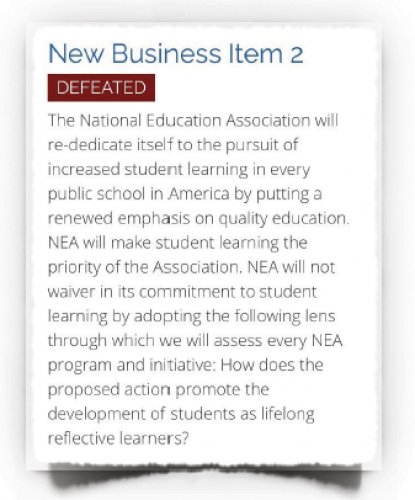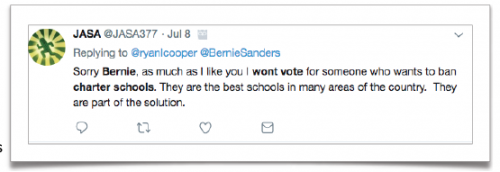Summer 2019 | Occasional Letter to Friends
|
Dear Friends, If you’re reading this Occasional Letter, thank you! While we inundate those tens of thousands of people who’ve joined our cause these many years with electronic notes, newswires, tweets, and more, we know it’s hard to keep up with all incoming stuff one gets. More importantly, we know paper still matters to a lot of us, particularly when we have important things to share. And in this already launched election “year,” boy do we have things to share! Hopefully by the time you finish this 110th Letter to Friends, you will know precisely what must be done to ensure our nation is led at the national, state and local level by people who understand great education matters to our nation, its security and the future of all its people. PROVIDENCE. Despite all the years of fact-based research and data that tells us how we can best ensure access to great education opportunity for all students — less bureaucracy, teacher hires made based on results rather than seniority, power for parents, flexibility for schools outside of the bureaucracy— it’s hard to believe there are still such horrific stories being told in American education. It’s ironic that a city named for hope in eternal salvation should produce results that are the antithesis of goodness and light. Only five percent of Providence 8th graders are proficient in math—just down the coast in the city of Newark, students with similar backgrounds make four times as much progress. So why was this national news early this July? It wasn’t simply that Providence’s own education Commissioner Angela Infante-Green said the city schools are so dysfunctional that she will not send her own two children there. The data was revealed by a Johns Hopkins University review which details how “(V)ery little visible student learning was going on in the majority of classrooms…[and] widespread agreement that bullying, demeaning, and even physical violence are occurring within the school walls at very high levels.” The cost of this abject failure? $18,000 per student. Meanwhile, the Rhode Island’s small but mighty charter school movement, serving the same kids, has produced great results at an average cost of $14,000 per student—67% of the cost of traditional public schools. This is a turning point for the state’s Democratic but very progressive Governor,Gina Raimondo, who has scored high in CER analyses for her openness to innovation and opportunity. She has been consulting with leaders in the movement to determine her next move. Let’s take a page out of New Orleans. The conditions of Providence should be considered a hurricane without the storm. Turn over the schools to the people and groups willing and able to run schools. Let parents choose. It’s simple. We must move with all deliberate speed to replace the system that the Blob continues to work so hard to protect, not just in Rhode Island but in every community and state that has, despite years of money, talk, and effort, failed to provide the education the kids need and deserve. The governors can play a role. The last several months have seen states’ executive leadership challenged by their own allies when it came to passing strong educational choice legislation. Though successful, Tennessee Governor Bill Leehad to settle for limited options because some state leaders lacked courage to make the right decisions on charters and school choice. Kentucky Governor Matt Bevin in 2018 failed to secure support to even fund the poorly crafted charter law his state had passed prior. The bottom line is: Governors need to realize that despite the protests, the unions remain a paper tiger. In states where the unions led “Red for Ed” walk-outs, like Arizona, higher teacher pay was already on the table. In West Virginia, “red” lawmakers passed a reform bill, though again much less bold than it could or should have been, acting as if there would be negative repercussions if they gave more parents choices. In years past, governors made sure their states were the laboratories of success for K-12 reform, giving life to the charter school movement, vouchers, state standards and more. Governors and lawmakers should not only return their focus to more choice but begin to make substantive changes to teacher pay —not how much but how we pay them— and the fact that inefficient and unaccountable districts siphon most of the funds dedicated to instruction before it ever reaches the classroom should be their primary concern. Higher Ed. The good news however is that the governors are turning their sights to the challenges of higher education, hoping to return strength to a sector which is under attack for lacking relevance and return on investment. This spring the National Governor’s Association announced its partnership with our friends at Strada Education Network, whose mission is to improve lives by forging clearer and more purposeful pathways between education and employment. NGA which will award grants and technical assistance to up to six states to help states align postsecondary and workforce priorities for adult learners through a data-driven approach to anticipating and meeting future workforce needs. This is incredibly exciting. The solution to making higher ed work isn’t about student loan debt and federal intervention, or about college vs no college. (see my Forbes piece about that) Only when higher ed is open to innovations that drive better outcomes and relevant pathways to success for students will the nation overcome cost and content challenges. PANDEMONIUM. The Democrat candidates for President seem to be in sheer pandemonium as they work to secure the endorsement of the powerful teachers unions for the coveted 2020 nomination. The unions have almost the entire Democratic field kowtowing to their perceived political might. Since Spring, the American Federation of Teachers (AFT) has been busy holding town halls with the Dem candidates. These beauty contests would supposedly help the nation’s second-largest —and most militant— teachers union determine whom it will endorse in the Democratic primary.
The NEA met for its annual Independence Day national assembly and did anything but celebrate freedom. Neither Providence —nor failing schools— were on their agenda, but requiring all candidates to publicly state their opposition to all charter school expansion was.
Huh? The NEA voted against renewing its commitment to increased student learning and to eliminate teacher testing (New Business Item 14) among the dozens of insane and unethical resolutions they adopted.
Beto O’Rourke’s star has fallen as well but not until he turned his back on the cause he was committed to, one his wife Amy helped lead in their native Texas. Joe Biden has supported not just charters but full school choice including vouchers for private schools, since a 1997 speech on the Senate floor through his two terms in the Obama administration. While his recently released education platform is silent on charters, at a May AFT sponsored candidate town hall he said that he did not support federal funding “for for-profit charter schools, period.” Maryland Congressman John Delaney, on the other hand, a long-time supporter of choice and the DC Opportunity Scholarship Program, noted in the last debate,“we’ve got to fix the public education system, it’s not delivering the results our kids need.” Thank God for people like former U.S. Senator Mary Landrieu, who shared with me on Reality Check, my weekly podcast, what she’d like to express to the current candidates and this whole country: “…That charter schools which are public schools, independent autonomous public schools, have from their beginning and continue to this day…to make great progress for kids that were left out of the traditional public schools system…kids in public schools that year after year were failing, not graduating, dropping out. Charter schools are innovative, autonomous schools that meet children where they are…they are not tied to these union contracts…that is not to say they are anti-union, they are just pro-child.” Parents. Potenza. Strength. The real power lies in the people —those who started innovative schools of choice… the people who govern them, who send their kids to them. Some 10 million adults are involved in the enterprise of education freedom, hardly a drop in the bucket. They represent the 3.5 million students in charters and another 500,000 in publicly-funded choice programs. That doesn’t include the millions more who support it. As we’ve written before, the multi-million member teachers union conglomerate has money and boots on the ground, but its power is only as strong as we let it be. Welcome to our “Summer Intensive Offensive!” Rather than sit back and wring our hands, we are taking the case directly to the people, through the people, using their example, their stories and their first-hand involvement to re-energize the movement that Time Magazine in 1994 called, “A Grassroots Revolt.” It was and is a revolt against failure, mediocrity, and power- hungry adults who protect systems and tradition rather than effective, student- centered, personalized opportunities for all students at all levels. Here’s a high-level summary of what we’ve begun, thanks to many of our members:
It’s been a busy summer and it is going to be an interesting —and busy— fall. Join us! Many people ask how they can help. Obviously there will be votes to be cast and you’ll want your candidates at every level to be committed to education opportunity and innovation and not just pay lip service to these things. But for them to want to even talk about it, they need to feel the heat. Here’s how you can help:
As always, we are open to your ideas, involvement, partnerships. Thank you. Happy Summer! Jeanne Allen PS. Our Thanks to the following amazing supporters who met our Summer Intensive Offensive financial challenge! Donald A. Best • Ann Amer Brennan • Eric Brooks • Building Hope PPS. Want to join our campaign to take Americans Back to School on School Reform? Call me today! 202-349-9020. Operators are standing by! ???? |















